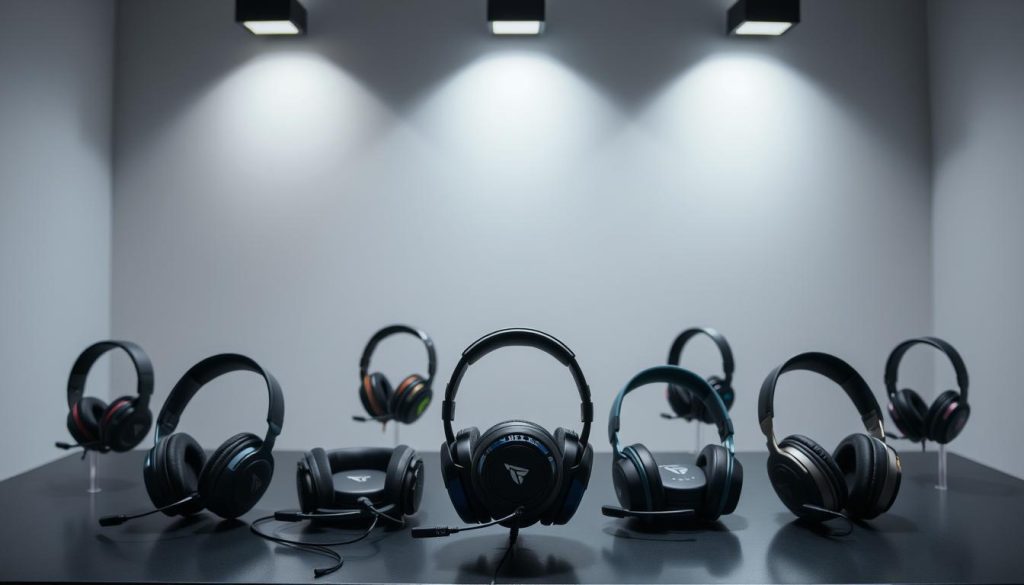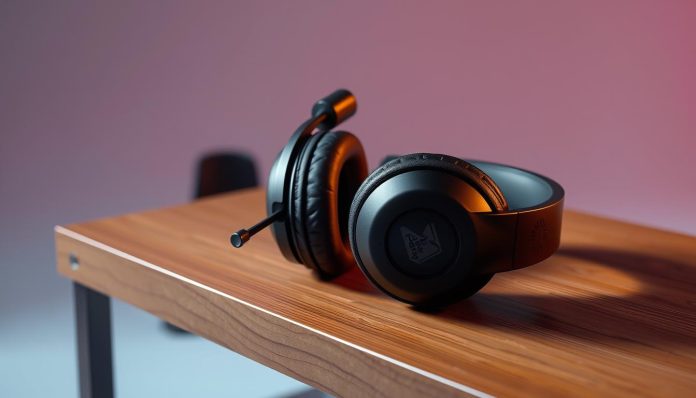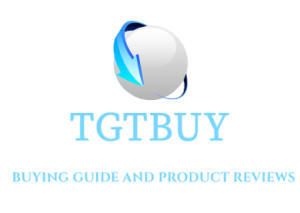Turtle Beach has deep roots in audio tech, evolving from studio sound tools into a go-to name for gamers. This short review shows how that legacy shapes comfort, clarity, and competitive edge today.
We’ll make it simple: match the right gaming headset to your platform and playstyle without overthinking specs. Expect clear notes on mic behavior, battery life, and on-ear controls so you know what to expect day to day.
We highlight signature audio features that matter in-game, like spatial cues and chat/game balance. That helps you judge sound quality and where each headset fits on the casual-to-competitive level.
Finally, we point out current U.S. buying perks such as free shipping thresholds and rewards multipliers to help you upgrade for less. Read on for quick, practical guidance from a friendly perspective.
Key Takeaways
- Brand history informs comfortable, clear headphones built for gamers.
- Find the right gaming headset by platform and playstyle, fast.
- Audio features like spatial cues shape in-game awareness.
- Practical notes on mic, battery, and controls matter more than raw specs.
- Current U.S. offers can lower the cost of stepping up your setup.
Our Expert Take on Turtle Beach Headsets in 2025
In 2025 we compare real-world reliability, sound clarity, and control simplicity across new models.
Quick verdict: the brand’s long run—starting headsets in 2005 and adding Xbox direct pairing in 2017—still shows. Strengths include thoughtful audio tuning, easy setup, and dependable wireless on many models.
We weigh new features against day-to-day play. That means checking chat intelligibility, spatial cues that help locate opponents, and whether on-ear controls actually reduce friction.
Community feedback and our team tests over the years shape which models earn a recommendation. Some are safe, everyday picks; others suit tournament players who want deep customization.
Note on ecosystem: recent moves like the PDP acquisition and Victrix integration hint at tighter ties between controllers and audio gear going forward.
- Value vs. upgrades: we call out which features matter in play, not just on paper.
- Wired vs. wireless: clear trade-offs on simplicity, latency, and battery life.
- Durability: long sessions reveal build choices that last.
Turtle Beach
A heritage in sound engineering helps the company turn pro audio tech into gamer-ready products.
From 1975 to headset leadership: Founded in Queens in 1975, the business moved from sound cards and music software into consumer headsets in 2005. That shift kept the same technical focus, now aimed at clarity and comfort for long sessions.

From sound cards to esports-grade audio: a quick brand history
The early years built credibility in pro audio engineering. That foundation led to the 2005 pivot into gaming products and steady refinements in tuning and fit through the years.
In 2017 the brand introduced headsets that pair directly to Xbox consoles wirelessly, a move that simplified many living-room setups. Partnerships with esports teams further sharpened product focus for competitive play.
What’s new now: PDP and Victrix join the family, plus VelocityOne Race
Recent growth reshapes the product line. The March 13, 2024 acquisition of PDP brought controller know-how in-house. Victrix and Neat Microphones add premium accessories to the ecosystem.
“VelocityOne Race (2024) signals a deeper commitment to simulation and tactile controls.”
| Milestone | Year | Impact |
|---|---|---|
| Founding (Octave/Voyetra) | 1975 | Pro audio roots and sound-card innovation |
| Headset launch | 2005 | Shift into consumer gaming products |
| Xbox direct pairing | 2017 | Simplified wireless console connectivity |
| PDP acquisition | 2024 | Controller expertise and product integration |
| VelocityOne Race debut | 2024 | Expansion into simulation and racing controls |
- Unified ecosystem: a single site link helps shoppers explore accessories, controllers, and audio together.
- Product breadth: offerings now span casual headsets to esports-ready kits and simulation gear.
Headset lineup at a glance: which Turtle Beach model fits your playstyle?
Start here to see which models prioritize wireless freedom, competitive tuning, or pocketable convenience.

Quick list to orient you: each series targets a clear use case so you can pick fast.
Recon series
The Recon line is entry-level wired value. It delivers reliable sound and clear chat without extra apps.
Choose Recon if you want no-fuss setup and good performance on a budget.
Stealth series
Stealth models add wireless freedom, surround features, and console-focused options. The Stealth 600 stands out for comfort and Xbox direct pairing on supported consoles.
These headsets work well for living-room play and longer wireless sessions.
Elite series
Elite designs aim at competitive players. Expect plush materials, refined tuning, and tournament-ready ergonomics.
Pick Elite when comfort and pro-level audio balance tilt your priorities.
Atlas and Battle Buds
Atlas targets PC-first users with esports-informed tuning and multi-platform friendliness.
Battle Buds bring a pocketable option for mobile play or travel. They’re a lightweight backup for quick matches.
- Within each series, models scale features like battery life, chat/game mix, and on-ear controls.
- If you game across platforms, verify that console-specific features you need are included in the variant you buy.
- Comfort matters: check clamping force and foam density for long sessions.
Performance and features: how Turtle Beach sounds, feels, and functions
A headset’s real value shows up when footsteps, gunfire, and comms stay distinct under pressure. This section runs through the key audio and usability features that shape play. Expect practical notes on tuning, mic behavior, comfort, and controls.
Audio quality and tuning
Positional clarity matters most. Across models the tuning favors crisp spatial cues so footsteps and reloads pop without losing low-end impact.
That balance helps you detect threats while keeping explosions satisfying. Elite models with advanced EQ let you fine-tune presets for different game types.
Mic clarity and chat
Team comms stay clear thanks to consistent game/voice balance. Mics deliver natural speech and useful flips-to-mute so you can silence quickly mid-match.
Comfort and build
Memory foam cushions and moderate clamping force give a stable, long-session fit. Frames aim for a durable yet light feel so fatigue stays low over marathon plays.
Software and controls
Companion software and SuperAmp options provide EQ presets and quick tweaks. On-ear buttons put volume, chat mix, and mute within reach so you can stay focused on the match.
Bottom line: the overall package blends tuning, durable comfort, and intuitive controls into a user-friendly system that works well for casual and competitive players.
Compatibility, support, and ecosystem
A headset that works everywhere can save you money, but platform-specific perks still matter.
Cross-platform notes: Most turtle beach headsets connect to xbox one and xbox series consoles, PlayStation, Nintendo Switch, PCs, and mobile. Check the variant: some features like direct wireless pairing on Stealth models only work with specific consoles.
PC players will find Atlas and other models plug into common desktop setups with useful presets. Mobile users can pick lightweight buds or wired headsets for quick sessions.
Beyond headsets
The ecosystem now includes VelocityOne simulators for flight and racing, plus expanded controller and accessory ranges after the PDP and Victrix additions. This makes it easier to match audio and input gear.
- Double-check console-specific features before buying.
- Use online support resources for setup steps or firmware updates.
- Follow the site’s direct link to explore PDP and Victrix products when you need controllers or premium accessories.
Value, price, and where to buy in the United States
Where you buy and when you buy can shave serious dollars off a new gaming headset. U.S. shoppers get predictable pricing tiers that scale from basic wired picks to full-featured wireless models. That makes it easy to match price to the exact features you need.
Current pricing landscape, promos, and Best Sellers to watch
Look at the Best Sellers list first. It’s a quick way to see what other customers choose now and can narrow your search fast. The official store highlights deals and shows platform-specific top sellers for Xbox One, Xbox Series, PlayStation, Nintendo, and PCs.
The site currently offers Free Shipping over $39 and 2X rewards points on headsets in September. Those promos boost savings and make mid-tier models more attractive to repeat buyers.
Shopping tips: Free Shipping over $39, double rewards on headsets, and platform shops
- Compare two or three models in the same price tier to spot real differences like chat/game mix or hinge design.
- Check product pages for clear spec tables so you confirm cables, wireless profiles, and warranty coverage.
- Consider total cost of ownership: cushions, replacement parts, and support affect long-term value.
- If you’ve bought past seasons, watch for small revisions that improve comfort or battery without big price shifts.
Conclusion
When choosing a final headset, focus on how sound detail, comfort, and console pairing fit your daily play.
Turtle Beach still offers solid audio and practical software across Recon, Stealth, Elite, Atlas, and Battle Buds. The Stealth 600 is a reliable wireless pick for Xbox One and Xbox Series players who want easy pairing.
Look for clear mic performance, long battery life, and simple on-ear controls. Consider VelocityOne Race and the wider simulation line if racing or flight gear matters to you.
Price perks like Free Shipping over $39 and 2X rewards make mid-tier models attractive. Pick two to three models, confirm console features, and buy the gaming headset that fits your routine and support needs.





